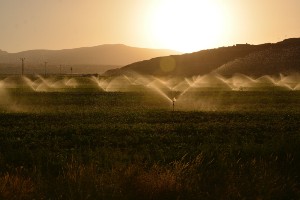Irrigated crops underestimation risks water shortages
01 May 2020

The area of agricultural land that will require irrigation in future could be up to four times larger than currently estimated, a new study has revealed.
Research by the University of Reading, University of Bergen and Princeton University shows the amount of land that will require human intervention to water crops by 2050 has been severely underestimated due to computer models not taking into account many uncertainties, such as population changes and availability of water.
The authors of the study, published in Geophysical Research Letters, argue forecasters and policy-makers need to acknowledge multiple future scenarios in order to be prepared for potential water shortages that would have huge environmental costs.
Dr Samuele Lo Piano, a postdoctoral researcher in the School of the Built Environment at the University of Reading who co-authored the study, said: “Assumptions being made on the size of irrigated areas in the future mean we are overlooking many potential challenges and making bad decisions.
“If the amount of water needed to grow our food is much larger than calculated, this could put severe pressure on water supplies for agriculture as well as homes. These findings show we need strategies to suit a range of possible scenarios and have plans in place to cope with unexpected water shortages.”
Models are widely used by policymakers to define strategies aiming at guaranteeing environmental welfare or managing climate change. If these models are inaccurate, policies risk being biased too.
The new research suggests that projections of irrigated areas made by the Food and Agriculture Organization of the United Nation and others have always underestimated the amount of irrigation required in future by basing them on other assumptions.
The study highlights that the potential global extension of irrigation might be twice, or in the most extreme scenario, even four times larger than what has been suggested by previous models.
Dr Arnald Puy, co-author and researcher at the University of Bergen and Princeton University, said: "When you design a model, there is a plethora of alternative ways of formulating it. If you chose just one way, you are ignoring these alternatives – disregarding perfectly reasonable scenarios.
“Previous models of irrigated areas, for instance, assumed that we perfectly know how much cropland we will have available in 2050, or how much the population will grow, or what the available volume of water will be in the future.
“But the truth is that we do not know with enough certainty. And previous models were designed as if we do.”
Agricultural land where crops cannot be supported by rainwater alone is often irrigated by channelling water from rivers or springs, sprinkler systems, or by controlled flooding. Increased irrigation in future would mean more water consumption, machinery, energy consumption and fertilisers, and therefore more greenhouse gas emissions.
The authors hope that the new knowledge can be used to design strategies on water and agriculture management that are flexible enough to work both in our current situation and in a situation of an unbearable environmental pressure on water and land resources.
Full reference:
Puy, A., Lo Piano, S., Saltelli, A. (2020); ‘Current models underestimate future irrigated areas’; Geophysical Research Letters; Doi: 10.1029/2020GL087360
